The latest details about Russia’s attack on Ukraine:
Civilian ISR corps in Kyiv
3:40 EST March 4
In better times, Ukrainian drone enthusiasts flew their gadgets into the sky to photograph weddings, fertilize soybean fields or race other drones for fun. Now some are risking their lives by forming a volunteer drone force to help their country repel the Russian invasion.
“Kyiv needs you and your drone at this moment of fury!” read a Facebook post late last week from the Ukrainian military, calling for citizens to donate hobby drones and to volunteer as experienced pilots to operate them.
One entrepreneur who runs a retail store selling consumer drones in the capital said its entire stock of some 300 drones made by Chinese company DJI has been dispersed for the cause. Others are working to get more drones across the border from friends and colleagues in Poland and elsewhere in Europe.
RELATED
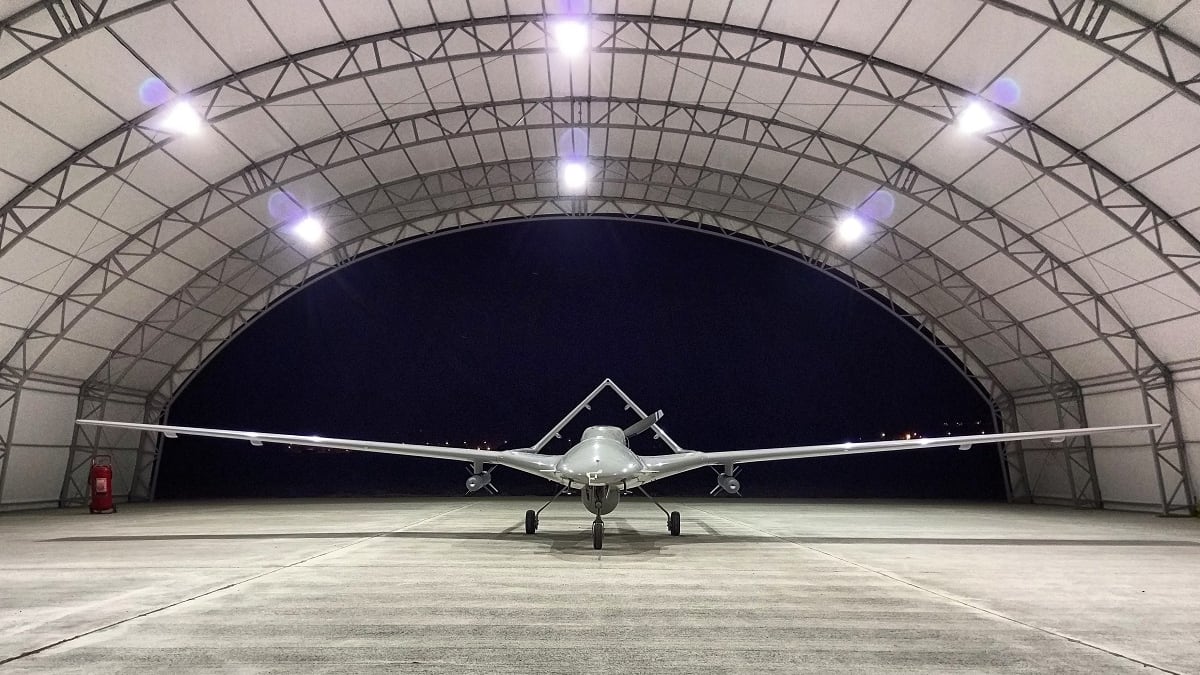
“Why are we doing this? We have no other choice. This is our land, our home,” said Denys Sushko, head of operations at Kyiv-based industrial drone technology company DroneUA, which before the war was helping to provide drone services to farmers and energy companies.
Sushko fled his home late last week after his family had to take cover from a nearby explosion. He spoke to The Associated Press by phone and text message Friday after climbing up a tree for better reception.
“We try to use absolutely everything that can help protect our country and drones are a great tool for getting real-time data,” said Sushko, who doesn’t have a drone with him but is providing expertise. “Now in Ukraine no one remains indifferent. Everyone does what they can.”
Unlike the much larger Turkish-built combat drones that Ukraine has in its arsenal, off-the-shelf consumer drones aren’t much use as weapons — but they can be powerful reconnaissance tools. Civilians have been using the aerial cameras to track Russian convoys and then relay the images and GPS coordinates to Ukrainian troops. Some of the machines have night vision and heat sensors.
But there’s a downside: DJI, the leading provider of consumer drones in Ukraine and around the world, can easily pinpoint the location of an inexperienced drone operator, and no one really knows what the Chinese firm might do with that data. That makes some volunteers uneasy. DJI declined to discuss specifics about how it has responded to the war.
“DJI makes its products entirely for civilian use, and we deplore any use of our products to cause harm,” company spokesperson Adam Lisberg said by email. “However, just like the manufacturers of pickup trucks or mobile phones, we are unable to control how they are ultimately used.”
Taras Troiak, a dealer of DJI drones who started the Kyiv retail store, said DJI has been sending mixed signals about whether it’s providing preferential access to — or disabling — its drone detection platform AeroScope, which both sides of the conflict can potentially use to monitor the other’s flight paths and the communication links between a drone and the device that’s controlling it. In the meantime, Ukrainian drone experts said they’ve been doing whatever they can to teach operators how to protect their whereabouts.
“There are a number of tricks that allow you to increase the level of security when using them,” Sushko said.
Sushko said many in the industry are now trying to get more small drones — including DJI alternatives — transported into Ukraine from neighboring European countries. They can also be used to assist search-and-rescue operations.
Ukraine has a thriving community of drone experts, some of whom were educated at the National Aviation University or the nearby Kyiv Polytechnic University and went on to found local drone and robotics startups.
“They’ve got this homebuilt industry and all these smart people who build drones,” said Faine Greenwood, a U.S.-based consultant on drones for civic uses such as disaster response.
Troiak’s DJI-branded store in Kyiv, which is now shuttered as city residents take shelter, was a hub for that community because it runs a maintenance center and hosts training sessions and a hobby club. Even the country’s president, Volodymyr Zelenskyy, once paid a visit to the store to buy a drone for one of his children, Troiak said.
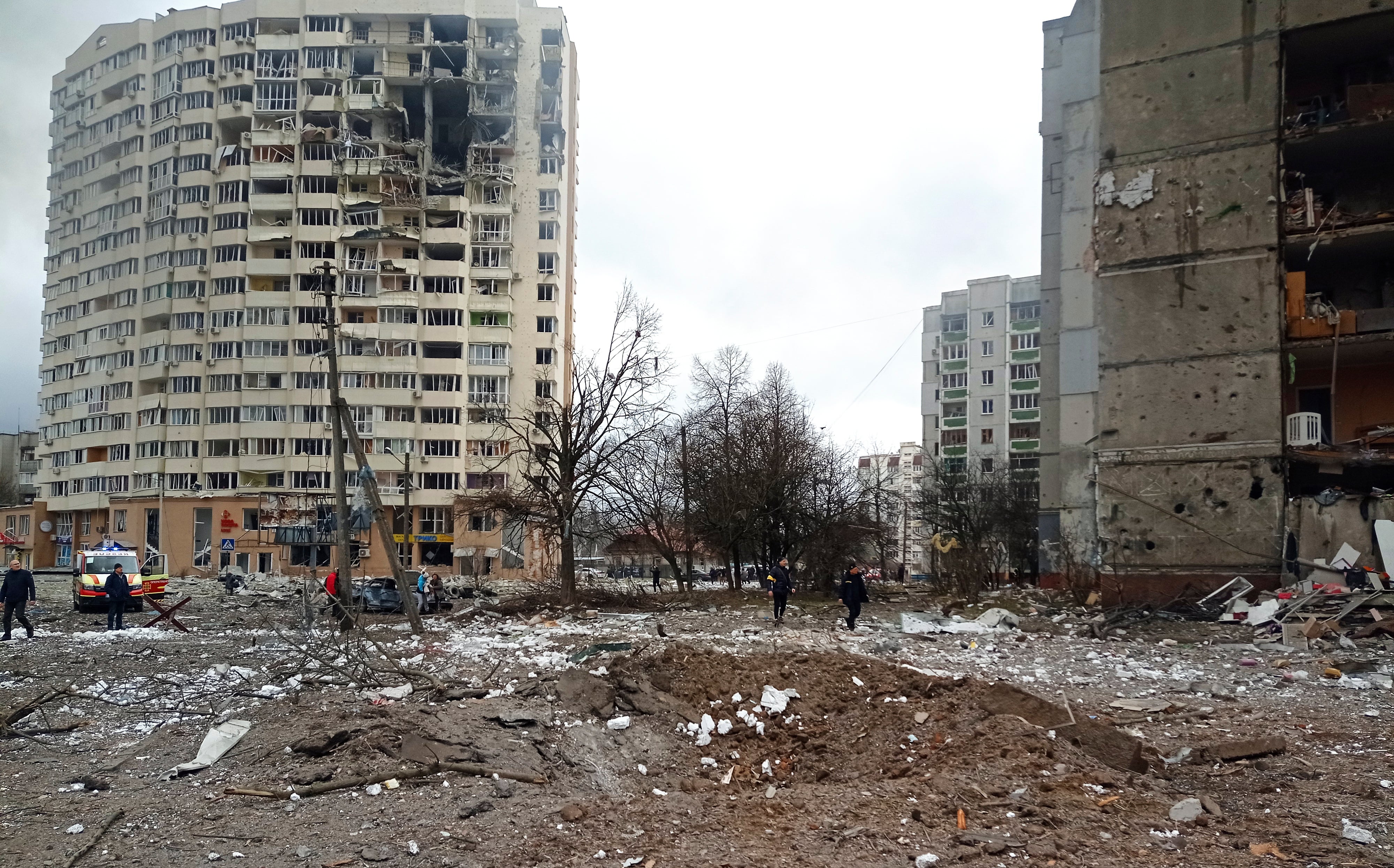
A public drone-focused Facebook group administered by Troiak counts more than 15,000 members who have been trading tips about how to assist Ukrainian troops. One drone photographer who belongs to the Ukrainian Association of Drone Racing team told The Associated Press he decided to donate his DJI Mavic drone to the military rather than try to fly it himself. He and others asked not to be named out of fear for their safety.
“The risk to civilian drone operators inside Ukraine is still great,” said Australian drone security expert Mike Monnik. “Locating the operator’s location could result in directed missile fire, given what we’ve seen in the fighting so far. It’s no longer rules of engagement as we have had in previous conflicts.”
Some in Ukraine’s drone community already have experience deploying their expertise in conflict zones because of the country’s long-running conflict with Russian-backed separatists in eastern Ukraine. Monnik’s firm, DroneSec, has tracked multiple instances just in the past year of both sides of that conflict arming small drones with explosives. One thing that Ukrainians said they’ve learned is that small quadcopter drones, such as those sold at stores, are rarely effective at hitting a target with explosive payloads.
“It would seem somewhat short-sighted to waste one,” said Greenwood, the consultant based in Cambridge, Massachusetts. “I assume the chief goal would be recon. But if things are getting desperate, who knows.”
DJI also has experience in responding to warfighters trying to weaponize its drones and used so-called “geofencing” technology to block drone movements during conflicts in Syria and Iraq. It’s not clear yet if it will do the same in Ukraine; even if it does, there are ways to work around it. But its rival U.S.-based drone company Skydio, without mentioning DJI by name, warned this week that “Russia and its allies -- including China — could force technology companies subject to their laws to suspend operation or to provide intelligence on Ukrainian forces.”
The California company said it has not previously sold products in Ukraine but is now looking at getting some in the hands of Ukraine’s defense forces.
Small civilian drones are no match against Russian combat power but will likely become increasingly important in a protracted war, leaving drone-makers no option to be completely neutral. Any action they take or avoid is “indirectly taking a side,” said PW Singer, a New America fellow who wrote a book about war robots.
“We will see ad-hoc arming of these small civilian drones much the way we’ve seen that done in conflicts around the world from Syria to Iraq and Yemen and Afghanistan,” Singer said. “Just like an IED or a Molotov cocktail, they won’t change the tide of battle but they will definitely make it difficult for Russian soldiers.”
-Matt O’Brien, AP Technology Writer. AP video journalist Nathan Ellgren contributed to this report.
Pentagon discourages Americans from joining up with Ukrainian forces
3:29 p.m. EST March 4
In response to a statement from a Ukrainian defense official in D.C. that roughly 3,000 Americans have expressed an interest in joining that country’s fight against Russia’s invasion, the Defense Department is urging any and all Americans to hang back.
“The State Department has made that very clear, in urging over so many weeks for Americans that are in Ukraine to leave, and urging Americans not in Ukraine not to go,” Pentagon spokesman John Kirby told reporters on Friday. “It is a warzone.”
RELATED
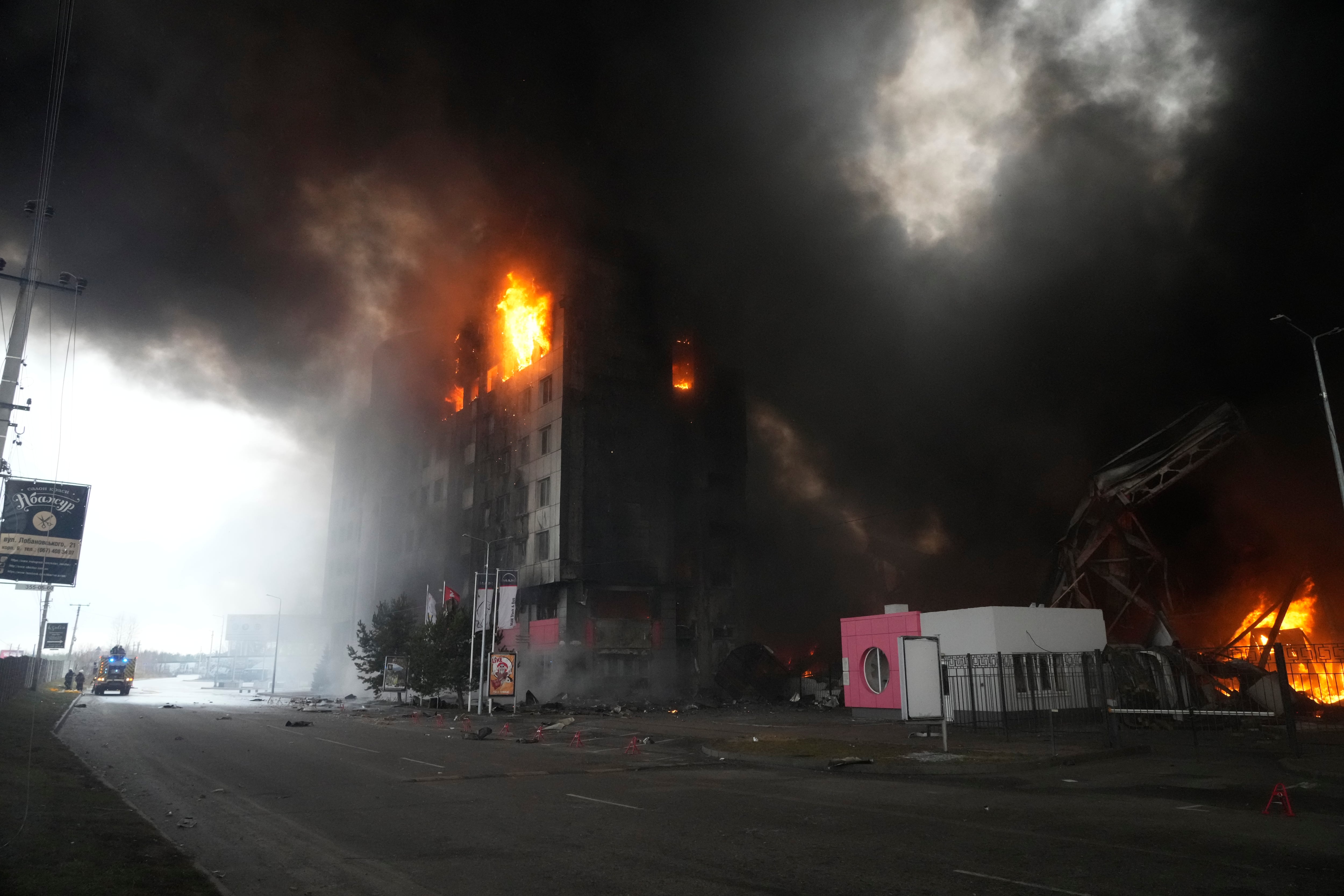
In anticipating of being outmanned by the Russians, Ukraine President Volodymyr Zelenskyy stood up “The International Legion of Territorial Defense of Ukraine.”
A Ukrainian official who spoke to Military Times urged those who don’t have professional military training to not come to fight.
“Should Americans want to help Ukraine, and it’s laudable that they do, the best way to do that is to find ways to contribute to the many non-governmental and humanitarian organizations that are trying to alleviate what has now become a very acute humanitarian crisis in Ukraine and in countries that are now bordering Ukraine, as the UN is estimated,” Kirby said.
-Meghann Myers, Military Times
US delays some intel to Ukraine in Russia war, lawmakers say
1:25 p.m. EST March 4
Some Democratic and Republican lawmakers say the United States is delaying providing some intelligence to Ukraine in its fight against Russia as the U.S. also seeks to limit any direct confrontation with Moscow.
The White House insists it is consistently sharing intelligence with Ukraine quickly. But a classified directive issued as the invasion began last week set effective limits on how quickly some tactical intelligence — the kind that shape minute-to-minute battle decisions — could be shared, according to two people familiar with the matter.
The directive from the Office of the U.S. Director of National Intelligence also limited sharing details about the specific locations of potential targets, according to the people, who spoke on the condition of anonymity because they were not authorized to publicly discuss intelligence matters. More details about the directive were not immediately available.
“We are adjusting as circumstances warrant and will continue to ensure that operators have flexibility to share intelligence as the conflict evolves,” said an intelligence official who spoke on condition of anonymity to discuss the classified directive.
RELATED
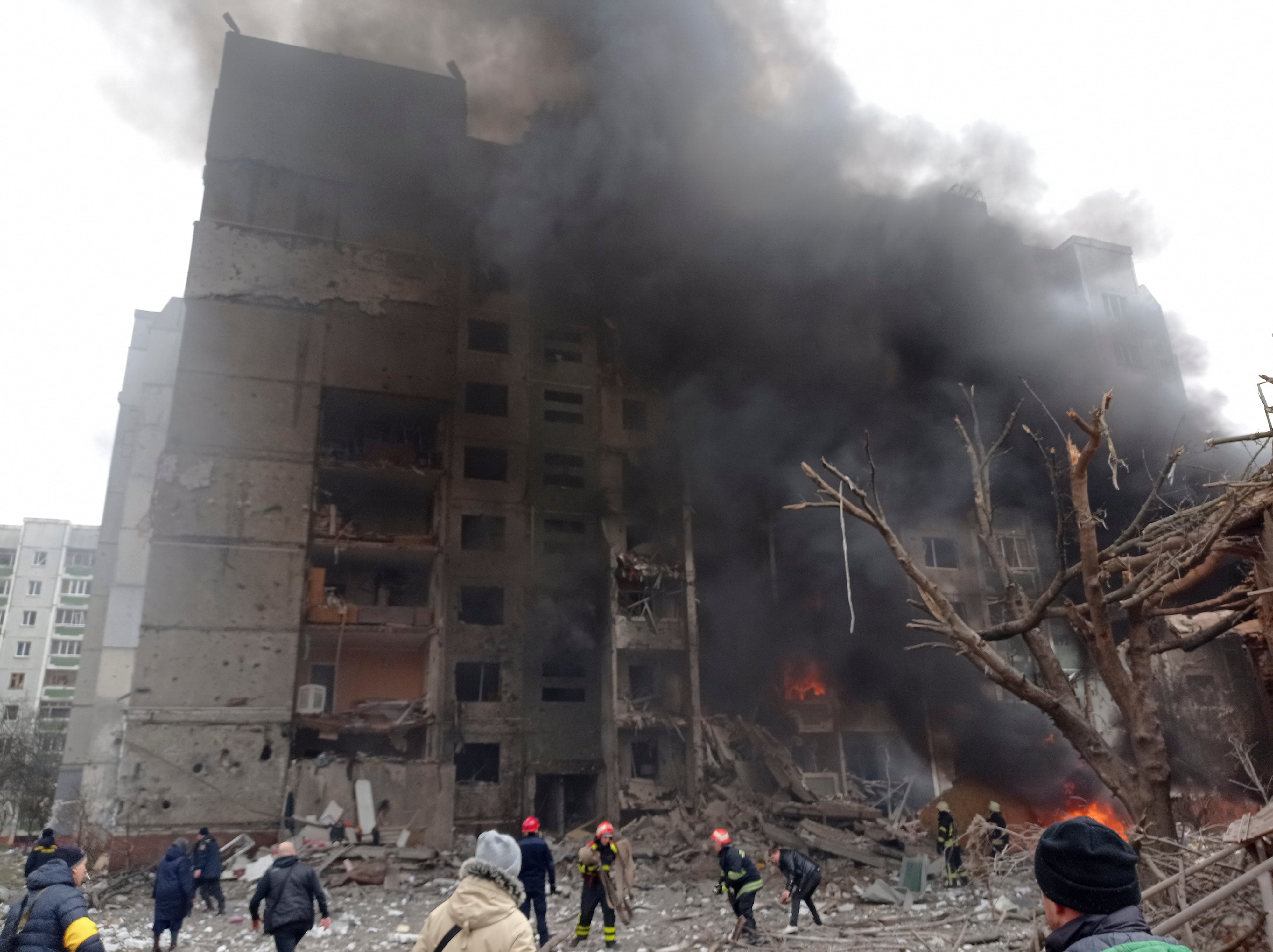
The Pentagon said it is doing as best as it can to share intelligence with Ukraine.
Without American troops and aircraft in the conflict directly, the U.S. is “doing the best we can, in as timely a fashion as possible, to provide the Ukrainians with useful intelligence,” a senior U.S. defense official said Friday.
“We do continue to provide them intelligence and information that we believe can be helpful for their ability to defend themselves,” the official said. “It’s also worth reminding or remembering that they are in the fight, and they can see things in real time that we aren’t going to be able to see. They have pretty robust intelligence capabilities of their own.”
The issuance of the directive reflects the fine line the U.S. is walking as it seeks to aid Ukraine while avoiding a direct conflict with nuclear-armed Russia. It is sending anti-aircraft weaponry and other arms to Ukraine and leads a global effort to impose severe sanctions aimed at crippling the Russian economy. But it also has ruled out sending American troops to Ukraine or declaring a no-fly zone that could result at U.S. forces engaging with Russian warplanes.
The sharing of intelligence can be especially delicate because of the risk of revealing U.S. sources and methods and the uncertainty of whether Russia may have infiltrated the Ukrainian government.
U.S. Rep. Adam Smith, a Washington Democrat who chairs the House Armed Services Committee, told MSNBC on Thursday that the U.S. was not providing “the type of real-time targeting that you see our military having gotten in conflicts like in Iraq ... because that steps over the line to making us participating in the war.” NBC earlier reported on delays in intelligence sharing with Ukraine.
One White House official disputed that characterization, saying the administration does not believe providing tactical intelligence to the Ukrainians would constitute participating in the war any more than it currently is by providing arms — which is distinct from actually putting U.S. forces in combat. The official was not authorized to discuss the White House’s thinking publicly and spoke on the condition of anonymity.
Some lawmakers in recent days have called on the Biden administration to provide more information. “This is a matter of life and death for Ukrainians, and information about where an invading Russian tank was 12 hours ago does squat to prevent civilian bloodshed,” said U.S. Sen. Ben Sasse, a Nebraska Republican who sits on the Senate Intelligence Committee.
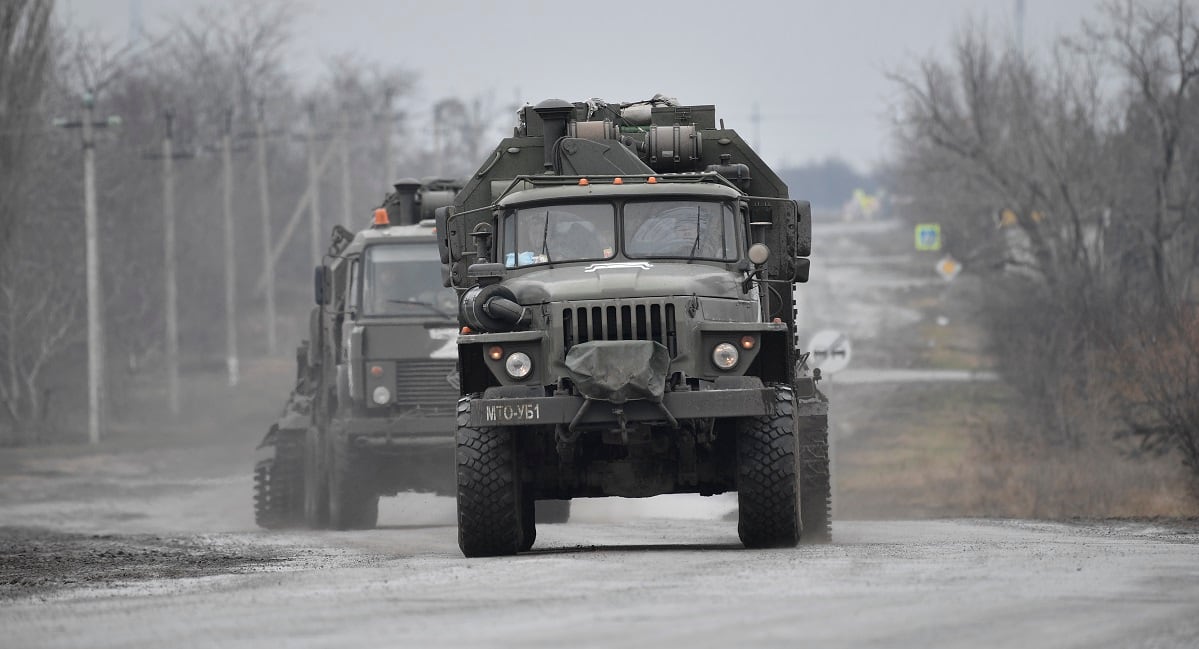
There have been cases in which tactical intelligence has been delayed for 12 hours or more, though most delays appear to be shorter, three people familiar with the matter said.
White House press secretary Jen Psaki on Thursday told reporters, “We have been sharing it, real time.”
“We have consistently been sharing intelligence,” Psaki said. “That includes information that the Ukrainians can use to inform and develop their military response to Russia’s invasion. That has been ongoing, and reports that suggest otherwise are inaccurate.”
Ukraine has its own intelligence service and has released some of its own findings about Russian plans to attack high-profile targets in the country or stage so-called “false-flag” operations — such as fabricated attacks by Ukrainian forces — that Moscow could use to justify its invasion.
The U.S. has a more limited intelligence sharing relationship with Ukraine than it does with other Western countries, notably the other four members of its so-called “Five Eyes” alliance — Australia, Canada, New Zealand and the United Kingdom. Administration officials insist that U.S. agencies have worked to provide Ukraine with as much information as possible about the Russian threat.
One limiting factor in what the U.S. can provide is Russia’s infiltration of the Ukrainian government. The Ukrainian military and intelligence services have long struggled with rooting out Russian spies or sympathizers. And while Ukrainian President Volodymyr Zelenskyy has sought closer ties to the West, other recent Ukrainian governments have been closer to Moscow and have key allies still in government.
Zelenskyy has had regular conversations with Biden and thanked the U.S. president and other Western leaders on Twitter for their support. But there have been occasional tensions between Washington and Kyiv over intelligence in the last several months, including Zelenskyy publicly breaking with the White House’s predictions that Russia would invade. Republicans in Washington also have said the U.S. could have provided more and better information about the Russian threat to Ukraine sooner than it did, a claim the White House rejects.
Ukraine Brig. Gen. Kyrylo Budanov, head of his nation’s defense intelligence agency, confirmed to Military Times Friday that Ukraine is receiving intelligence from the U.S., but did not offer specifics.
Ukrainian Vice Prime Minister Mykhailo Fedorov this week published an open letter to commercial satellite companies asking them for high-resolution satellite imagery. “We badly need the opportunity to watch the movement of Russian troops, especially at night when our technologies are blind in fact!” read the letter.
Several commercial satellite companies have contracts with the U.S. government, which has been providing imagery to the Ukrainians, people familiar with the matter said.
-Nomaan Merchante, James LaPorta, Zeke J. Miller, The Associated Press, Joe Gould, Defense News, Howard Altman, Military Times.
Russia, US talk on Ukraine deconfliction line; NATO nixes no-fly zone
11:57 a.m. EST March 4
The Defense Department has been able to get Russia on the phone in recent days, as part of a larger effort to create line of communication so both sides could talk through any events that might be misunderstood as aggressive toward one or the other.
Since before Russia began its invasion of Ukraine, there had been concerns at DoD that Russian miscalculation would pull the U.S. into a fight.
“In our initial test of it, you know, they answered the phone so we know that they know who’s calling,” a senior U.S. defense official told reporters Friday, “At least in terms of the initiation, of the setting up of it, it worked and they did answer the line.”
Upwards of 90% of the 190,000 troops Russia amassed at the Ukrainian border pre-invasion are deployed in the war, the defense official said, though efforts to take the country’s capital and topple the government continue to be stalled.
The Russia advance on Kyiv remains roughly 17 miles outside the city center, the official said, as it has been most of the week.
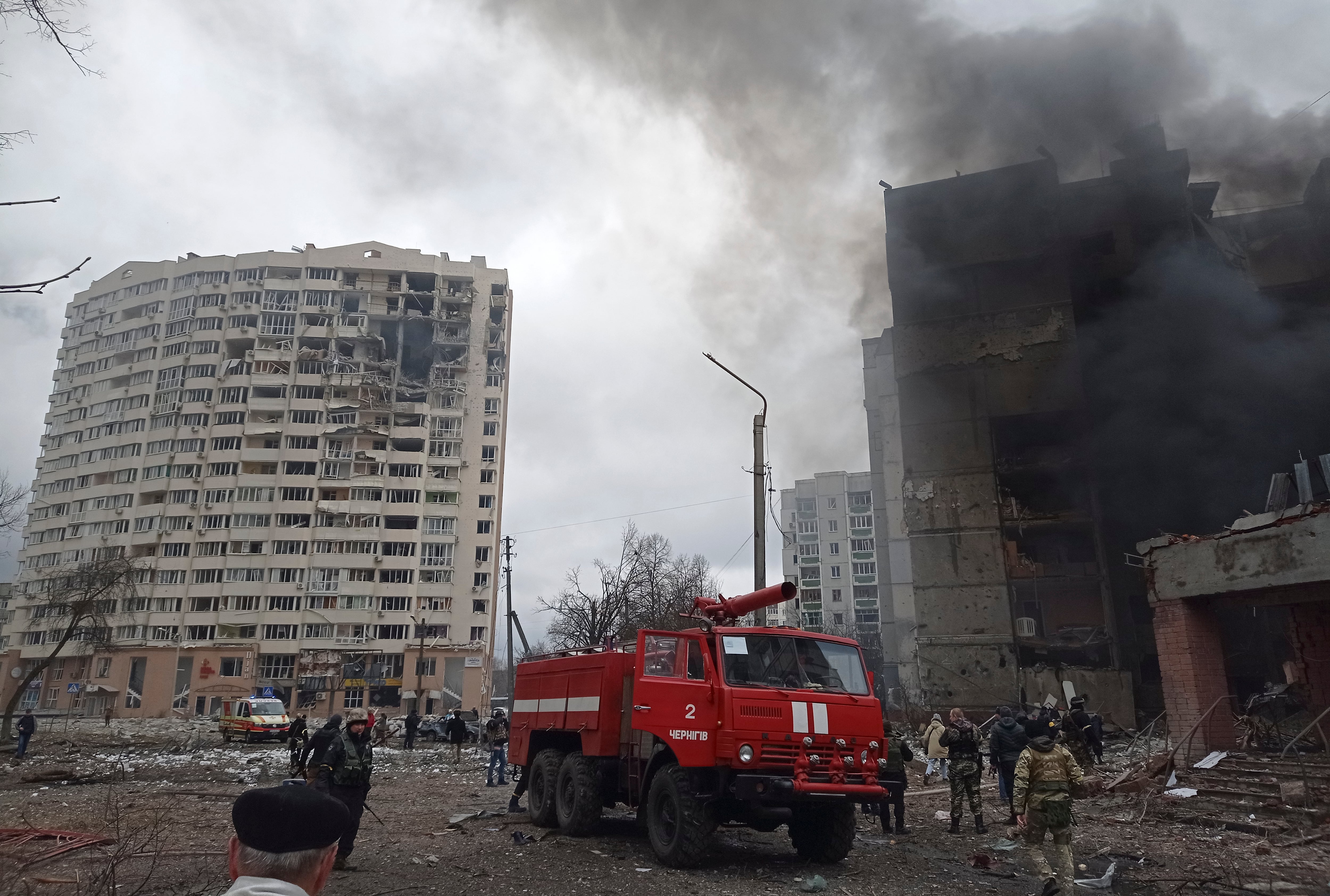
“I think all of us have been tremendously impressed by how effectively the Ukrainian Armed Forces have been using the equipment that we’ve provided them,” another senior U.S. defense official said Friday. “And I think that you know, Kremlin watchers have also been surprised by this and how they have slowed the Russian advance and performed extremely well on the battlefield.”
Though efforts in the north are slowed, an official said Russian forces in the south continue to advance and succeed. The official couldn’t confirm whether the city of Kherson is under Russian control.
While Russians continuously bombed the Zaporizhzhia nuclear power station into Friday, according to reports, the official couldn’t say whether Russia currently controls it.
“We are in no position to refute claims that they are in charge of the nuclear power plant, but we don’t know exactly right now what that control means and what it looks like,” the official said.
- Meghann Myers, Military Times
No NATO no-fly zone
9:30. am. EST March 4
NATO countries refused on Friday to police a no-fly zone over Ukraine, warning that such a move could provoke widespread war in Europe with nuclear power Russia, the organization’s top civilian official said.
Speaking after chairing a meeting with U.S. Secretary of State Antony Blinken and his counterparts, NATO Secretary-General Jens Stoltenberg acknowledged the suffering of the Ukrainian people, as Russia ramps up its use of heavy firepower, shelling cities and other sites, forcing more than a million people out of the country.
“What is taking place now in Ukraine is horrific. It’s painful and we see human suffering, we see destruction at a scale we haven’t seen in Europe since the Second World War,” he said. But, he added: “We are not going to move into Ukraine, neither on the ground, nor in the Ukrainian airspace.”
Under a collective security guarantee binding NATO’s 30 member countries — Article 5 of its founding treaty — all allies must come to the defense of an ally if it finds itself under attack. Any shooting down of a NATO warplane by Russia could trigger that clause.
“The only way to implement a no-fly zone is to send NATO fighter planes into Ukrainian airspace, and then impose that no-fly zone by shooting down Russian planes,” Stoltenberg said. He said allies believe that “if we did that, we would end up with something that could end in a full-fledged war in Europe.”
Ukrainian President Volodymyr Zelenskyy has appealed for the West to enforce a no-fly zone over his country, most recently after a fire overnight at one of Ukraine’s nuclear plants, the largest in Europe.
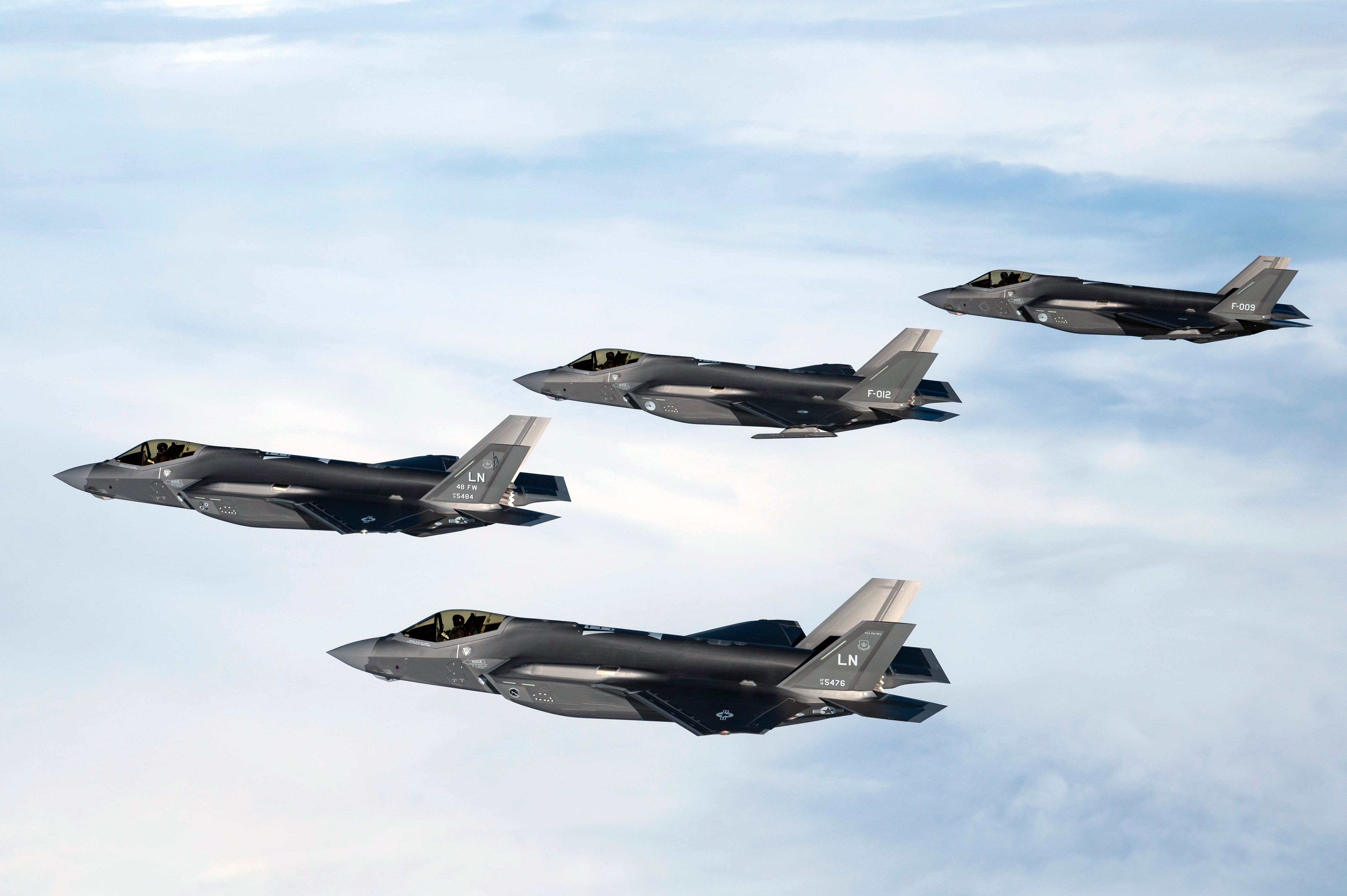
But, Stoltenberg said, “we are not part of this conflict, and we have a responsibility to ensure that it does not escalate and spread beyond Ukraine, because that would be even more devastating and more dangerous.”
NATO members and officials are alarmed at Russian President Vladimir Putin’s threat to use nuclear weapons should one of their number get involved in his war on Ukraine. NATO has no weapons itself, but the United States, Britain and France are nuclear powers, like Russia.
NATO has mobilized thousands of troops backed by aircraft, tanks and heavy equipment and deployed them to countries on its eastern flank near Ukraine and Russia, such as Estonia, Latvia, Lithuania, Poland and Romania, which are nervous about Putin’s intentions for their future.
At a second round of talks between Ukrainian and Russian delegations Thursday, Putin warned Ukraine that it must quickly accept the Kremlin’s demand for its “demilitarization” and declare itself a neutral country, thereby renouncing any bid to join NATO.
NATO insists that its door remains open to any European country that wants to join and can fulfill the obligations of membership. Stoltenberg said that the world’s biggest security organization will also step up cooperation with already close allies Finland and Sweden.
Blinken also held talks in Brussels Friday with members of the Group of Seven major powers and European Union countries.
-Lorne Cook, The Associated Press
Russians take over plant
5:53 a.m. EST March 4
Ukrainian firefighters on Friday extinguished a blaze at Europe’s biggest nuclear plant that was ignited by a Russian attack and no radiation was released, U.N. and Ukrainian officials said, as Russian forces pressed their campaign to cripple the country despite global condemnation.
The head of the United Nations’ atomic agency said that a Russian “projectile” hit a training center at the Zaporizhzhia plant. Ukrainian officials have said Russian troops took control of the overall site, but the plant’s staff are continuing to ensure its operations. International Atomic Energy Agency Director-General Rafael Mariano Grossi sad that Russian forces were at the plant, but the Ukrainians were in control.
Ukraine’s state nuclear plant operator Enerhoatom said that three Ukrainian soldiers were killed and two wounded in the attack. Grossi said two people were injured in the blaze that broke out.
Ukraine’s state nuclear regulator earlier said that no changes in radiation levels have been recorded so far after the plant came under attack. Grossi later said no radioactive material was released.
The attack caused worldwide concern — and evoked memories of the world’s worst nuclear disaster, at Ukraine’s Chernobyl.
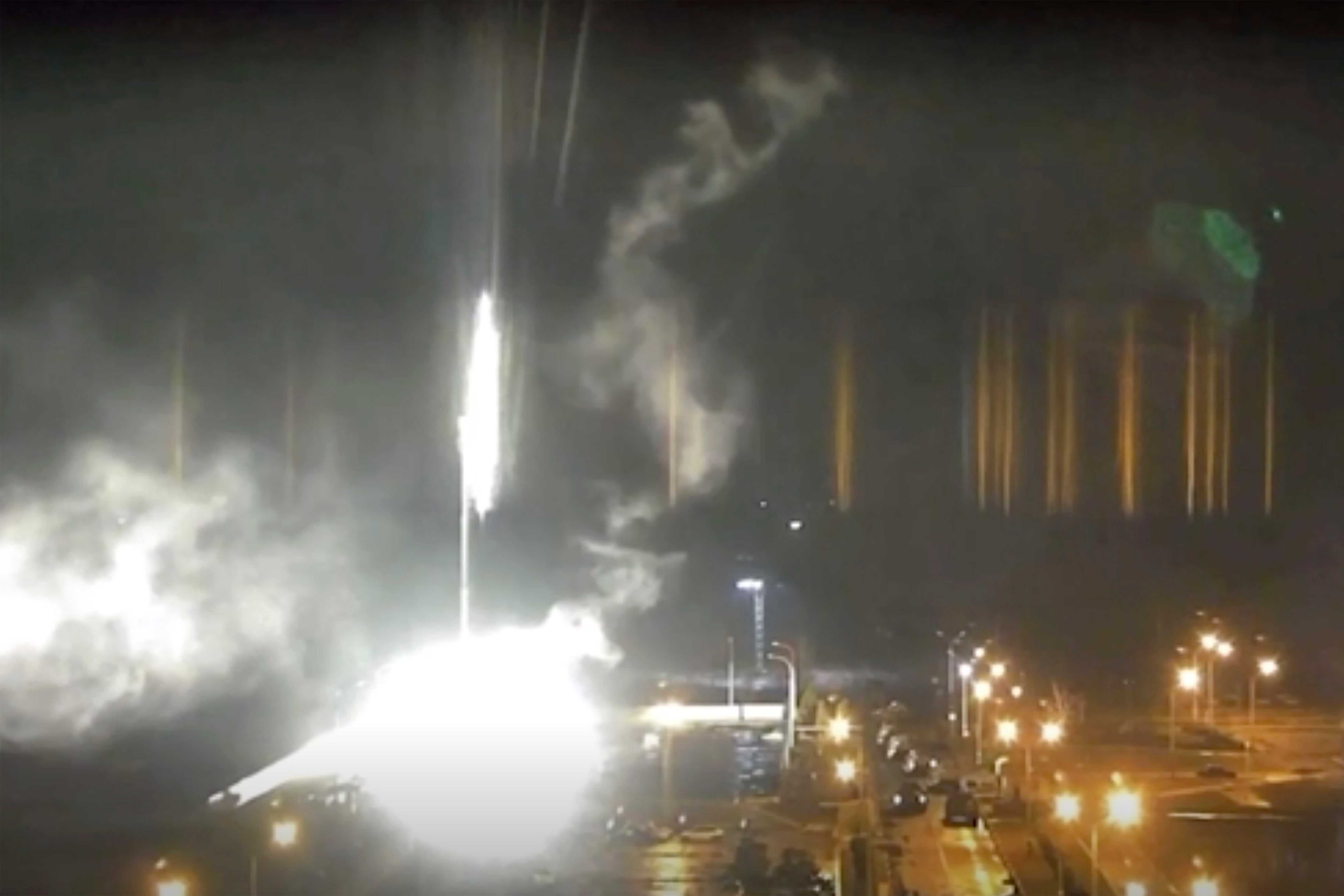
The shelling of the plant came as the Russian military advanced on a strategic city on the Dnieper River near where the facility is located, and gained ground in their bid to cut the country off from the sea. That move would deal a severe blow to Ukraine’s economy and could worsen an already dire humanitarian situation.
With the invasion in its second week, another round of talks between Russia and Ukraine yielded a tentative agreement to set up safe corridors to evacuate citizens and deliver humanitarian aid to the country, overturned by a war that has sent more than 1 million fleeing over the border and countless others sheltering underground night after night. A handful cities are without heat and at least one is struggling to get food and water.
Initial reports conflicted over whether one or two fires broke out at the plant in the city of Enerhodar. Nuclear plant spokesman Andriy Tuz told Ukrainian television overnight that shells fell directly on the facility, and set fire to reactor No. 1, which is under renovation and not operating, and to an administrative training building.
On Friday morning, officials only referenced a blaze at the training building when they said that all fires at the plant were out — which Grossi also confirmed. The regional military administration reported unspecified damage to the compartment of reactor No. 1, but said it does not affect the safety of the power unit.
The nuclear regulator said staff are studying the site to check for other damage.
Grossi confirmed Friday that the building hit was a training center and “not part of the reactor.” He said he did not know what hit the plant but called a “projectile” from Russian forces.
He said that only one reactor at the plant is operating, at about 60% capacity.
The confusion itself underscored the dangers of active fighting near a nuclear power plant. It was the second time since the invasion began just over a week ago that concerns about a nuclear accident or a release of radiation materialized, following a battle at Chernobyl.
RELATED

The regulator noted in a statement on Facebook the importance of maintaining the ability to cool nuclear fuel, saying the loss of such ability could lead to an accident even worse than 1986 Chernobyl disaster or the 2011 Fukushima meltdowns in Japan. It also noted that there is a storage facility for spent nuclear fuel at the site, though there was no sign that facility was hit by shelling.
Leading nuclear authorities were worried but not panicked. The assault led to phone calls between Ukrainian President Volodymyr Zelenskyy and U.S. President Joe Biden and other world leaders. The U.S. Department of Energy activated its nuclear incident response team as a precaution.
The Zaporizhzhia regional military administration said that measurements taken at 7 a.m. Friday (0500 GMT) showed radiation levels in the region “remain unchanged and do not endanger the lives and health of the population.” Nuclear officials from Sweden to China also said no radiation spikes have been reported.
“The fire at the (nuclear plant) has indeed been extinguished,” Enerhodar Mayor Dmytro Orlov announced on his Telegram channel Friday morning. His office told The Associated Press that the information came from firefighters who were allowed onto the site overnight.
British Prime Minister Boris Johnson called for an emergency meeting of the U.N. Security Council in “coming hours” to raise the issue of Russia’s attack on the plant, according to a statement from his office.
In an emotional speech in the middle of the night, Zelenskyy said he feared an explosion that would be “the end for everyone. The end for Europe. The evacuation of Europe.”
But most experts saw nothing to indicate an impending disaster.
The International Atomic Energy Agency said the fire had not affected essential equipment and that Ukraine’s nuclear regulator reported no change in radiation levels.
“The real threat to Ukrainian lives continues to be the violent invasion and bombing of their country,” the American Nuclear Society said in a statement.
Orlov, the mayor of Enerhodar, said Russian shelling stopped a few hours before dawn, and residents of the city of more than 50,000 who had stayed in shelters overnight could return home. The city awoke with no heat, however, because the shelling damaged the city’s heating supply, he said.
Loud shots and rocket fire were heard late Thursday around the plant. Later, a livestreamed security camera linked from the homepage of the plant showed what appeared to be armored vehicles rolling into the facility’s parking lot and shining spotlights on the building where the camera was mounted.
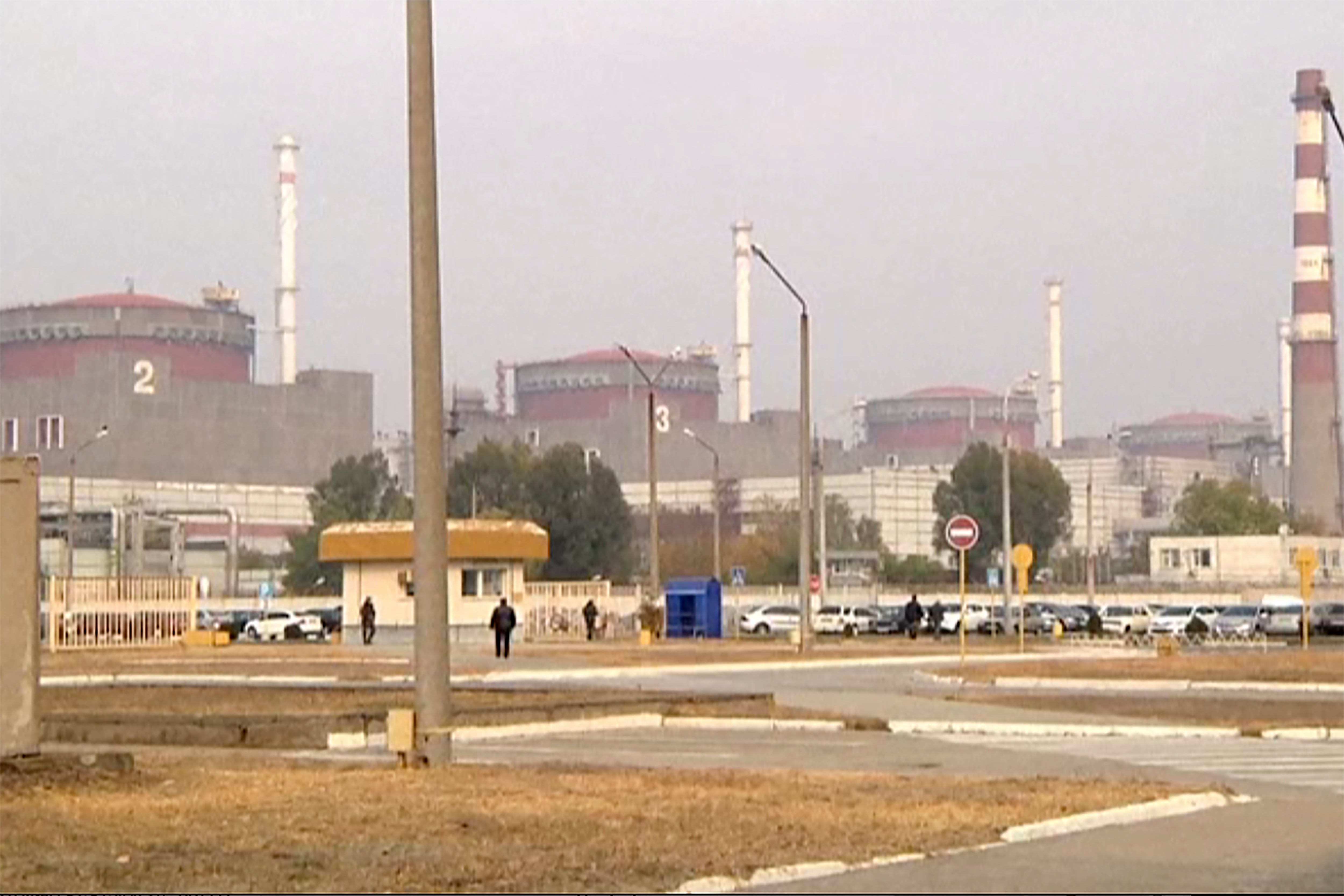
Then there were what appeared to be muzzle flashes from vehicles, followed by nearly simultaneous explosions in surrounding buildings. Smoke rose into the frame and drifted away.
Russian President Vladimir Putin’s forces have brought their superior firepower to bear over the past few days, launching hundreds of missiles and artillery attacks on cities and other sites around the country and making significant gains in the south.
The Russians announced the capture of the southern city of Kherson, a vital Black Sea port of 280,000, and local Ukrainian officials confirmed the takeover of the government headquarters there, making it the first major city to fall since the invasion began a week ago.
Troops, meanwhile, advanced on Zaporizhzhia, a strategic city near the plant of the same name. A Russian airstrike on Thursday destroyed the power plant in Okhtyrka, leaving the northeastern city without heat or electricity, the head of the region said on Telegram.
“We are trying to figure out how to get people out of the city urgently because in a day the apartment buildings will turn into a cold stone trap without water, light or electricity,” Dmytro Zhyvytskyy said.
Heavy fighting continued on the outskirts of another strategic port, Mariupol, on the Azov Sea. The battles have knocked out the city’s electricity, heat and water systems, as well as most phone service, officials said. Food deliveries to the city were also cut.
Associated Press video from the port city showed the assault lighting up the darkening sky above deserted streets and medical teams treating civilians, including a 16-year-old boy inside a clinic who could not be saved. The child was playing soccer when he was wounded in the shelling, according to his father, who cradled the boy’s head on the gurney and cried.
Ukraine’s defense minister said Friday that the flagship of its navy has been scuttled at the shipyard where it was undergoing repairs in order to keep it from being seized by Russian forces. Oleksii Reznikov said on Facebook that the commander of the frigate Hetman Sahaidachny decided to flood the ship.
“It is hard to imagine a more difficult decision for a courageous soldier and crew,” Reznikov said.
Overall, the outnumbered, outgunned Ukrainians have put up stiff resistance, staving off the swift victory that Russia appeared to have expected. But Russia’s seizure of the Crimean Peninsula in 2014 gives it a logistical advantage now in the country’s south, with shorter supply lines that smoothed the offensive there, said a senior U.S. defense official, speaking on condition of anonymity.
Ukrainian leaders called on the people to defend their homeland by cutting down trees, erecting barricades in the cities and attacking enemy columns from the rear. In recent days, authorities have issued weapons to civilians and taught them how to make Molotov cocktails.
“Total resistance. ... This is our Ukrainian trump card, and this is what we can do best in the world,” Oleksiy Arestovich, an aide to Zelenskyy, said in a video message, recalling guerrilla actions in Nazi-occupied Ukraine during World War II.
At the second round of talks between Ukrainian and Russian delegations Thursday, Putin warned Ukraine that it must quickly accept the Kremlin’s demand for its “demilitarization” and declare itself neutral, renouncing its bid to join NATO.
The two sides said that they tentatively agreed to allow cease-fires in areas designated safe corridors, and that they would seek to work out the necessary details quickly. A Zelenskyy adviser also said a third round of talks will be held early next week.
The Pentagon set up a direct communication link to Russia’s Ministry of Defense earlier this week to avoid the possibility of a miscalculation sparking conflict between Moscow and Washington, according to a U.S. defense official who spoke on condition of anonymity because the link had not been announced.
Jim Heintz. Yuras Karmanau reported from Lviv, Ukraine. Mstyslav Chernov reported from Mariupol, Ukraine. Sergei Grits in Odesa, Ukraine; Francesca Ebel, Josef Federman and Andrew Drake in Kyiv; and other AP journalists from around the world contributed to this report.





